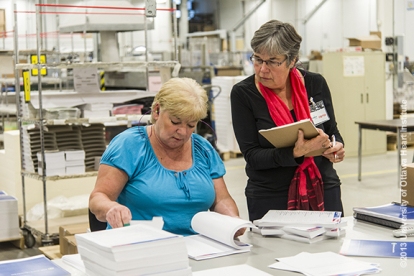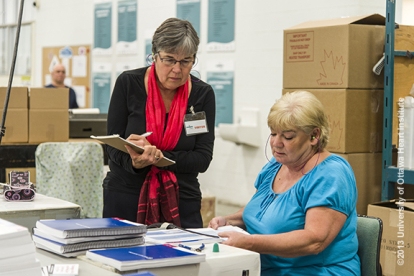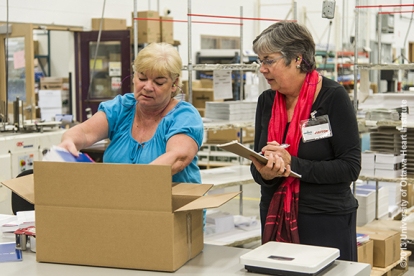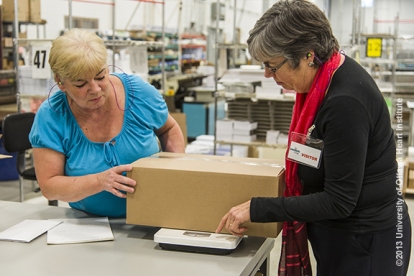When you enter the rehabilitation area of the University of Ottawa Heart Institute, it looks very much like a gym—treadmills, stationary bikes and elliptical trainers, all surrounded by a four-lane track. So you might think rehabilitation is all about physical fitness, but there’s much more to it than that.
In fact, cardiac rehabilitation at the Heart Institute helps patients get back on their feet in every respect after a cardiac event, helping not only with being physically active but also with making healthy food choices, dealing with stress and even getting back to work.
The Heart Institute takes an integrated approach to rehabilitation, recognizing the need to deal with all its many aspects.
Jane Brownrigg, the Clinical Manager of Cardiac Rehabilitation, said that the program at the Heart Institute is among the best she’s seen. Indeed, when she talks to her colleagues at other centres, there are few who have even a fraction of the facilities and services that the Heart Institute has to offer. The Heart Institute team comprises nurses, physiotherapists, dietitians, psychologists, social workers, vocational counsellors and physicians—a truly wide range of disciplines.
The Heart Institute takes an integrated approach to rehabilitation, recognizing the need to deal with all its many aspects. There’s good reason for this comprehensive approach, Brownrigg said, one that’s solidly based in research evidence.
“We know that how people manage stress and how they eat have huge ramifications for their cardiac health.” In fact, she added, research shows that increased stress leads to increased risk of chronic disease (such as heart disease), and once a person has a chronic disease, increased stress leads to a worse prognosis.
It’s all tied in together, Brownrigg said. If work is too stressful and takes too many hours of people’s time, how can they eat well, go for that 30-minute walk at lunch or quit smoking? The Heart Institute program recognizes how intertwined all of these issues are and addresses them in a coordinated way. The goal, she said, is to enable people to manage their own conditions.
“We provide education and support for self-management as a tool with which to carry on your life,” Brownrigg explained.
Making the Healthy Choice Easier
Take, for instance, healthy eating. We know that making healthy food choices—lots of fruits and vegetables, foods low in sodium and primarily “good” fats—is better for our health. But according to dietitian Kathleen Turner, it’s not helpful educating people about how to get all these elements into their diets. What they really want is practical help. So she focuses more on food as a whole rather than its component parts and nutrients.
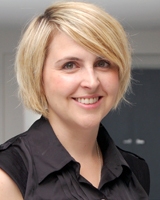
“People don’t care about what kind of fat they’re eating—they want to know what to make for dinner,” she said. “It can be so overwhelming to think about how to prepare a whole week of healthy meals.”
Turner tries to answer these questions through group sessions on the ABCs of heart-healthy eating and weight management and through short five-minute talks during exercise classes, on topics such as meal timing, fruits and vegetables and fats and sodium. She also has a “hot topic,” which she uses to pick up on what is current in the media and to provide some media literacy tips to help people assess for themselves what they read or see on television. And for those who need more individual attention, Turner does one-on-one counselling.
“The healthy choice is usually the hard choice,” Turner said. “But the more people cook at home, the more in control they are.” So she focuses her efforts on helping people learn to plan meals, find good recipes online or in a cookbook, and shop for the ingredients.
As just one dietitian serving the entire outpatient population, Turner’s long-term goal is to help her patients find resources in the community. Surprisingly, one of the best places to go is the local grocery store. Some grocery stores have dietitians on staff who will do everything from helping with finding recipes to conducting store tours that show people where to find healthier alternatives.
Learning to Communicate with Patients
When Heart Institute social worker Bob Pelletier isn’t busy taking care of the needs of patients in Cardiac Rehabilitation, he instructs first-year medical students, teaching them the finer points of interviewing patients. Pelletier is one of 17 social workers who team up with family physicians to work with small groups of students at the Heart Institute and The Ottawa Hospital.
Physicians in training need to learn a lot of things. The University of Ottawa medical school has put talking to patients near the top of the list. There’s more to illness than just symptoms. Illness is specific to the individual. The ability to communicate is crucial to understanding the impact of disease on that person and how he or she experiences it.
The most difficult thing, Pelletier said, is to “encourage the students to feel comfortable within themselves.” Without that ability, it can be more challenging to be comfortable with others.
A crucial part of the work is bringing the students into contact with actual patients in various settings, including the emergency room, the obstetrics-gynecology ward—and the Heart Institute. The last is Pelletier’s favourite. Heart patients, he said, are different from other patients because their disease is so tied up with both lifestyle and genetics.
And while feedback from Pelletier and his co-instructors is important, direct feedback from the patients is even more valuable, as they tend to be extremely honest with the students.
Most of all, medical students are learning that it is never just an illness or, in this case, a cardiac event in front of them, but a person who is experiencing that cardiac event. So learning to deal with the person behind the disease is a critical element in delivering quality patient care. Pelletier and his colleagues are helping students do that, one patient at a time.
Promoting Adjustment and Support
Re-entering daily life after a cardiac event can be stressful. There’s a lot to deal with. But Bob Pelletier, a Heart Institute social worker, is there to help.
“I’m the problem solver. I’m the networker. I get things coming out of the blue and I do something about them,” Pelletier said. “I haven’t had a typical day in 30 years.”
Most of what Pelletier does on any given day is engage patients in counselling to promote adjustment and support them to make healthy lifestyle changes. But the list of his activities goes on for more than a page. Financial coping is a big part of it, everything from how to maintain income while recovering, or if unable to return to work at all, to how to pay for expensive medications. Navigating the often-confusing world of health care and social services is also important. And sometimes, it’s about very practical questions, like how to obtain an accessible parking permit and understanding what having that permit means.
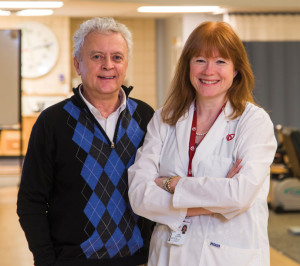
That last item may not seem so important, but it can be a significant obstacle. Many people aren’t aware that an accessible parking permit not only gives access to handicapped parking spots. It also allows the holder to park for free at a meter for up to four hours or to park in a no-parking zone. Pelletier makes sure patients know these things. For patients who meet the strict eligibility criteria, the permit “can make the difference between being able to come to programs here or not,” he said.
There are other resources available in the community to support patient needs, from Employment Insurance sick benefits, to long-term disability through the Canada Pension Plan or the Ontario Disability Support Program, to coverage for drug costs through Ontario’s Trillium Drug Program. The problem is, he explained, many people aren’t aware that these resources are available, and the application process can be daunting. That’s where Pelletier comes in. He helps patients fill out the appropriate forms and makes sure the information they need to be successful is there in their applications.
Pelletier is grateful for the financial assistance that comes from the Heart Institute Patient Alumni. When all else fails, that money is there to pay for medications or for transition care in a retirement home before a person is ready to go home alone.
Part of the intake process for cardiac rehabilitation is to find out what each patient needs to help him or her cope. For instance, every patient referred to rehabilitation is assessed using the Hospital Anxiety and Depression Scale, or HADS. The time following a cardiac event, such as valve surgery, heart transplant or bypass surgery, can be emotionally challenging. The HADS is used as a screening tool to help assess what the patient is feeling and thinking with respect to anxiety and depression.
This assessment process drives Pelletier’s strategy by identifying the particular kinds of help each person needs. In some cases, depending on the results, a patient may be referred for a social work, psychological or psychiatric assessment. For those who don’t need the specialized level of care that a psychologist or psychiatrist can provide, stress management groups are available. Pelletier co-leads these groups with vocational counsellor Laura Cupper. “The success of the Cardiac Rehabilitation program is that we have a really strong team,” said Pelletier, “and we’re all interconnected.”
Taking Care of Business
“I do anything that relates to work,” said Cupper, who has been a vocational counsellor for 30 years.
The most straightforward part of her job is helping people ease back into work gradually. Fatigue is common following a cardiac event and a full-time return to work, even to a desk job, may be beyond some people’s capability. She will work with the patient and his or her employer to negotiate a staged return.
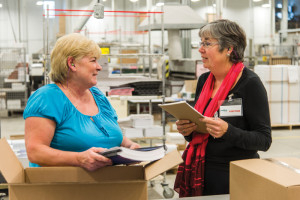
Returning to work can pose challenges to those who have had a heart attack or cardiac surgery. Heart Institute vocational counsellor Laura Cupper (right) often travels to work sites to assess job-related demands that could pose problems for heart disease patients. Here she observes bindery worker Maureen Lafontaine at a printing facility of the Lowe-Martin Group. (See the photo gallery)
It gets a little more complicated when a person’s job involves physical effort. In these cases, Cupper will do a physical demand analysis to learn more about what the job entails and work with the patient’s physician to determine whether the patient is capable of returning to that job.
“I’ve done everything from weighing garbage in a nursing home to sitting on a skidder at a logging site,” she said.
Cupper will also set up simulations in which patients can mimic their work tasks. She has had patients who work as plasterers, as deliverers of building materials, and as Beer Store employees, lifting and stacking beer cases. All of them have simulated their activities for her so they can figure out together whether the activities are safe.
And this is where the stress management comes in. Jobs are stressful. That’s not going to change. What can change, Cupper said, is the way people think about that stress. “I’m a huge believer in cognitive restructuring. No matter what the stressor is, how you handle it will depend on how you think about it.”
Cupper’s job isn’t done until a patient is back at work and stable. Sometimes this can take up to six or eight weeks, during which time she’ll keep in touch with the patient by phone. “We can all go back to work for one day,” she pointed out. “But can we keep going back to work?”
Cupper’s job also involves recognizing when going back to work isn’t an option. In those cases, she will help with arranging for disability insurance, whether through a private insurance company or public sources, such as the Canada Pension Plan.
After 30 years, she still finds the work rewarding. “I really do like it all,” she said. “Seeing someone get back to work successfully and safely is rewarding.”
Moving into the Digital Future
But it’s also a way to create virtual communities. Just as people in nutrition workshops and stress management groups support one another and provide tips on how to improve their health and reduce stress, so can they in the electronic world.
“We know from Alcoholics Anonymous and Weight Watchers that peer interaction is motivational, and virtual communities are one way to do that,” said Brownrigg. “People do want and need education, but they also need that health coach for behaviour change.” And that, she said, sums up the rehabilitation team: “We’re really in the behavioural change business.”



